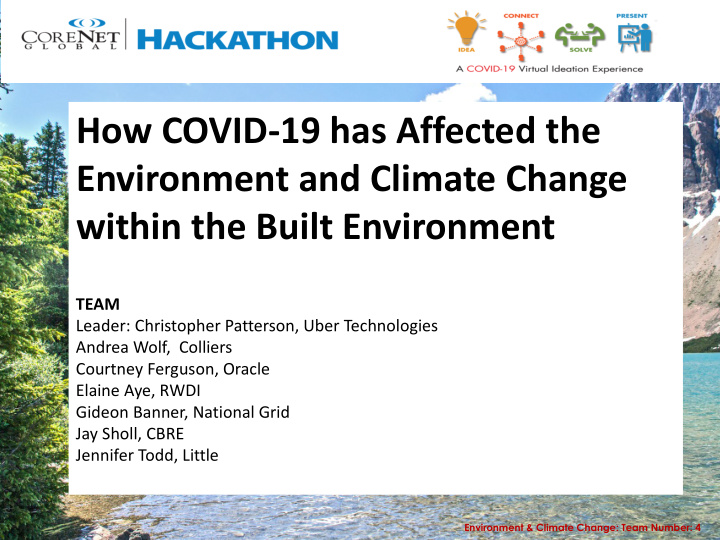



How COVID-19 has Affected the Environment and Climate Change within the Built Environment TEAM Leader: Christopher Patterson, Uber Technologies Andrea Wolf, Colliers Courtney Ferguson, Oracle Elaine Aye, RWDI Gideon Banner, National Grid Jay Sholl, CBRE Jennifer Todd, Little Environment & Climate Change: Team Number: 4
Climate change has a direct impact on human health. We must understand that impact and create a resilient society. Environment & Climate Change: Team Number: 4
3 Pillars 3. Buildings 1. Community 2. Transportation More responsible management Transit oriented development The high prevalence of working of urban growth will be crucial will gain momentum to reduce from home will continue post- to support sustainable reliance on cars and long pandemic, driving a new urbanization. As an industry, commutes and increase perspective on location we should bring our voices to reliance on localized smart strategies, energy needs, educate policy makers and solutions. In turn, costs will go workplace design, training and those involved with updating down for companies based on education and the desire to building codes so that together a reduction in business travel avoid enclosed, dense spaces. we can create new public and subsidized commuter health requirements. costs. Environment & Climate Change: Team Number: 4
COMMUNITIES RECOMMENDATIONS: • Establish a comprehensive public health policy More responsible management of urban • Update building codes to conform with HPIs growth will be crucial to guarantee sustainable • Incentivize a path to carbon neutral/net zero urbanization. We should educate lawmakers environment and those updating building codes so that we • Embrace all levels of environmental justice • Address social inequities: certain communities are creating new public health requirements. are facing higher rates of infection and death from Covid-19 and Climate Change Environment & Climate Change: Team Number: 4
TRANSPORTATION RECOMMENDATIONS : • Transit oriented development will gain Take indoor guidelines to the public transit - constant sanitization, hand washing, covering the momentum to reduce reliance on cars and mouth and nose, and cycling fresh air long commutes and increase reliance on • Develop strict guidelines and protocol around localized smart solutions. In turn, costs will cleaning and sanitization, and be very transparent about their practices. go down for companies based on a • Communities and government agencies should reduction in business travel and subsidized incentivize public transit authorities commuter costs. Environment & Climate Change: Team Number: 4
BUILDINGS RECOMMENDATIONS The high prevalence of working from • Investment in Building Automation Systems, retraining and air filtration will be enhanced home will continue post-pandemic, • Investment in technology to create Smart Buildings driving a new perspective on location • Partnerships between key stakeholders to promote strategies, energy needs, workplace residential efficiency programs as residential energy design, training and education and the consumption will increase desire to avoid enclosed, dense spaces. • Developers and owners to track their full carbon footprint by including tenants and employees
Conclusion COVID-19 and Climate Change have and will continue to affect the built environment, both in the way companies operate and how employees behave. All pillars of the built environment must develop or adopt key frameworks around resiliency, sustainability, health, and wellness into their design, construction, and operational requirements. Environment & Climate Change: Team Number: 4
Recommend
More recommend